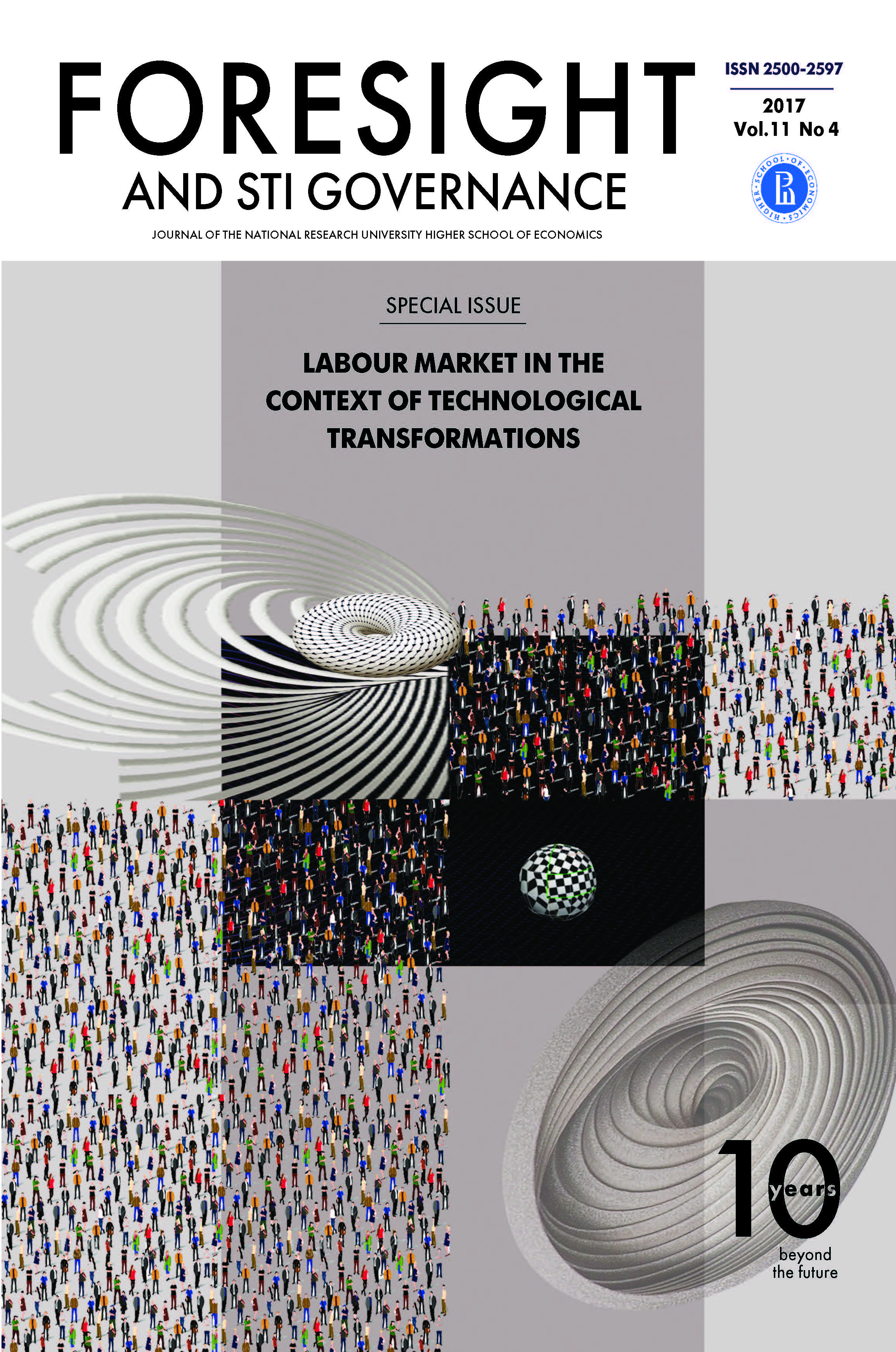Abstract
The article considers recruiting via the internet as an organizational innovation in Russian companies. Using data from a survey of employers and RLMS-HSE, we measured the scale of internet-use by employers for recruiting and by employees for the job search, and the factors influencing them. In general, the characteristics of employees and workplaces were in line with one another. Amid companies, internet use was more common in the retail sector, among privately owned and financially successful firms. The internet was more actively used by workers with higher or specialized education from big cities. Internet search complements other search channels and has become the second most popular channel after searching for work through relatives and friends.
References
Autor D.H. (2001) Wiring the Labour Market // Journal of Economic Perspectives. Vol. 15. № 1. P. 25-40.
Beard T.R., Ford G.S., Saba R.P., Seals Jr. R.A. (2012) Internet use and job search // Telecommunications Policy. Vol. 36. № 4. P. 260-273.
Brenčič V., Norris J.B. (2012) Employers' On-Line Recruitment and Screening Practices // Economic Inquiry. Vol. 50. № 1. P. 94-111.
Fountain C. (2005) Finding a Job in the Internet Age // Social Forces. Vol. 83. № 3. P. 1235-1262.
Garg R., Telang R. (2012) To be or not to be linked on LinkedIn: Job search online social networks. Heinz College Working Paper, June 2012. Pittsburgh, PA: Carnegie Mellon University.
Jansen B.J., Jansen K.J., Spink A. (2005) Using the web to look for work: Implications for online job seeking and recruiting // Internet Research. Vol. 15. № 1. P. 49-66.
Jovanovic B. (1979) Job Matching and the Theory of Turnover // Journal of Political Economy. Vol. 87. № 5. P. 972-990.
Kuhn P. (2014) The Internet as a Labour market matchmaker // IZA World of Labour. № 18. Режим доступа: https://wol.iza.org/uploads/articles/18/pdfs/internet-as-a-Labour-market-matchmaker.pdf?v=1, дата обращения 17.02.2016.
Kuhn P., Mansour H. (2014) Is Internet Job Search Still Ineffective? // The Economic Journal. Vol. 124. № 581. P. 1213-1233.
Kuhn P., Skuterud M. (2000) Job search methods: Internet versus traditional // Monthly Labour Review. № 123. P. 3-11.
Kuhn P., Skuterud M. (2004) Internet Job Search and Unemployment Durations // American Economic Review. Vol. 94. № 1. P. 218-232.
Marchal E., Mellet K., Rieucau G. (2005) Job Board Toolkits: Internet Matchmaking and the Transformation of Help-Wanted Ads. Centre d’études de l’emploi Working Paper № 50. Noisy-le-Grand: Centre d’études de l’emploi.
Nakamura A.O., Shaw K.L., Freeman R.B., Nakamura E., Pyman A. (2009) Jobs Online // Studies of Labour Market Intermediation / Ed. D.H. Autor. Cambridge, MA: National Bureau of Economic Research. P. 27-65.
OECD, Eurostat (2005) Oslo Manual. Guidelines for Collecting and Interpreting Innovation Data (3rd ed.). Paris: OECD, Eurostat.
Sakurai K., Okudo Y. (2015) Job Seeker Trends 2015. Boston, МА: Boston Consulting Group.
Stevenson B. (2003) The Internet, Job Search, and Worker Mobility. Stanford, CA: Stanford University.
Stevenson B. (2008) The Internet and Job Search. NBER Working Paper № 13886. Cambridge, MA: National Bureau of Economic Research.
Suvankulov F., Lau Chi Keung M., Ho Chi Chau F. (2012) Job search on the internet and its outcome // Internet Research. Vol. 22. № 3. P. 298-317.
Weinburger C.M., Strider S.H., Vengrouskie E.F. (2015) Social Media Job Searches and the Strength of Veteran Ties // Human Resource Management Research. Vol. 5. № 6. P. 133-153.
Авраамова Е., Гурков И., Карпухина Г., Левинсон А., Михайлюк М., Полушкина Е., Стучевская О. (2006) Требования работодателей к системе профессионального образования / Под ред. Т. Клячко, Г. Красновой. М.: МАКС Пресс.
Анкор (2014) Рекрутмент в компаниях России. Взгляд работодателей. М.: Анкор. Режим доступа: https://ancor.ru/f/1/client/Recruitment%20v%20Rossii.pdf, дата обращения 17.02.2016.
Гимпельсон В., Лукьянова А. (2006) Быть бюджетником в России: удачный выбор или несчастная судьба? // Экономический журнал Высшей школы экономики. Т. 10. № 4. С. 557-589.
Денисова И., Лазарева О. (2006) Наем или переобучение: опыт российских предприятий. Препринт WP3/2006/11. М.: ГУ ВШЭ.
Кузнецова И., Гостева С., Грачева Г. (2008) Методология и практика статистического измерения инновационной деятельности в экономике России: современные тенденции // Вопросы статистики. № 5. С. 30-46.
НИУ ВШЭ (2016) Индикаторы информационного общества: 2016. Статистический сборник. М.: НИУ ВШЭ.
Нарышкина А. (2007) Моделирование процесса поиска работы при переходе от учебы к работе. Препринт WP15/2007/03. М.: ГУ ВШЭ.
Росстат (2015b) Труд и занятость в России: 2015. М.: Росстат. Режим доступа: http://www.gks.ru/free_doc/doc_2015/trud15.pdf, дата обращения 07.04.2016.
Росстат (2015а) Выборочное наблюдение по вопросам использования населением информационных технологий и информационно-телекоммуникационных сетей за 2014 г. М.: Росстат.
Рощин С., Маркова К. (2004) Выбор каналов поиска работы на российском рынке труда. Препринт EERC 04/05. М.: Консорциум экономических исследований и образования.
Рощин С., Травкин П. (2015) Дополнительное профессиональное обучение на российских предприятиях // Журнал Новой экономической ассоциации. № 2. С. 150-171.
Стукен Т. (2008) Эффективность использования социальных сетей при трудоустройстве // Вестник Омского университета (Экономика). № 3. С. 70-75.
Тихонова И. (2015) Новые возможности рекрутинга XXI века // Научный альманах (Социологические науки). № 7. C. 1277-1280.
Шарунина А. (2016) Где бюджетнику жить хорошо: анализ межсекторных различий в оплате труда в регионах России // Журнал Новой экономической ассоциации. № 2. С. 105-128.

This work is licensed under a Creative Commons Attribution 4.0 International License.

